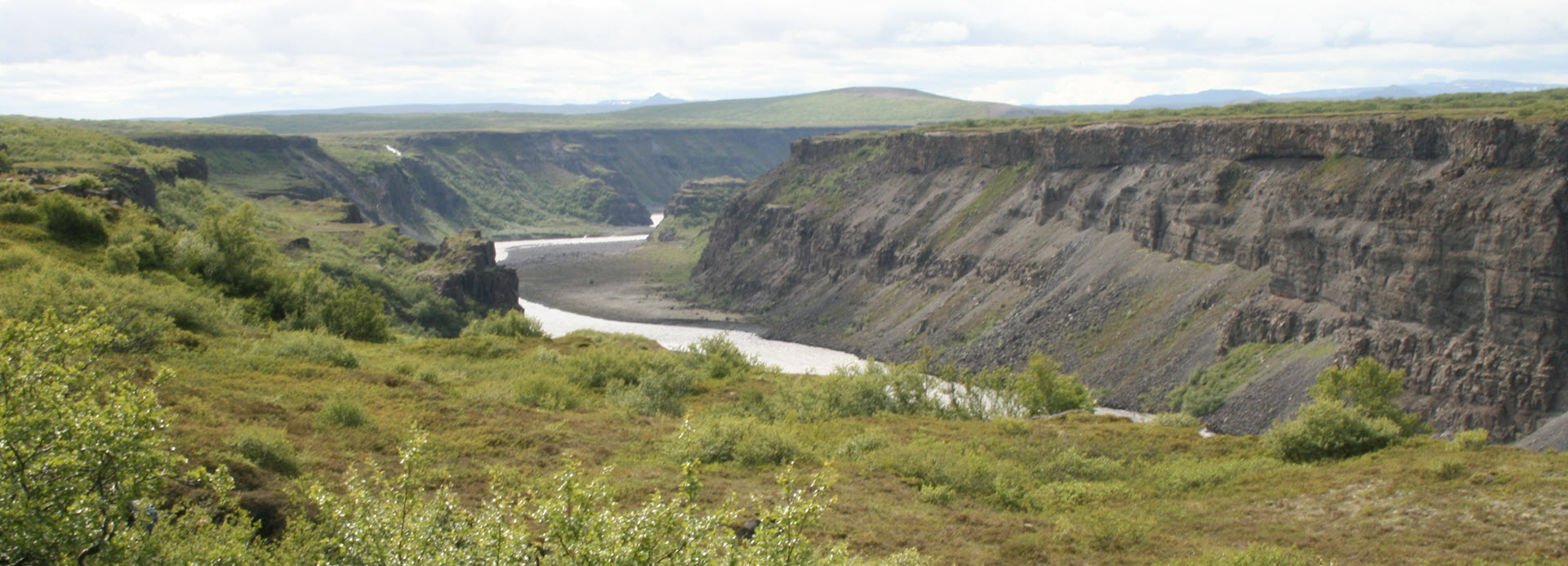Jökulsárgljúfur
Vatnajökull National Parkl
Jökulsárgljúfur-Vatnajökull National Park

Shaping the landscape from glacier to sea
For thousands of years, Jökulsá á Fjöllum, one of Iceland’s largest rivers, has continued to flow from under the glacier Vatnajökull and wound its way through a landscape of diverse aspects for a distance of about 200 km until merging with the sea in Öxarfjörður bay. On its long journey, the river has carved numerous channels into the highland bedrock and to the west of Hólsfjöll it cascades from a tall rocky ledge, forming the huge waterfall Dettifoss, plunging into, magnificent canyons which extend all the way down to the bridge over the river on highway 85. The canyons (Icelandic: gljúfur), which take their name from the river, Jökulsárgljúfur, are approximately 25 km long, half a kilometre wide and in several locations they extend to a depth of over 100 metres.
Awesome beauty
While Icelanders based their living almost exclusively on agriculture, their primary criterion of natural beauty was the suitability of the land for farming. With the growing diversification of employment and industry, improved education and prosperity, people began, to an increasing extent, to find beauty in the wilderness with its highlands and mountains, despite their barren and rugged appearance. Eventually, areas which were thought to surpass others in their unique natural characteristics came to be protected.
National Park
A National Park was established in Jökulsárgljúfur canyons and the surrounding area in 1973 and expanded to include Ásbyrgi in 1978. When Vatnajökull National Park was established in 2008, Jökulsárgljúfur became a part it. The park includes all the canyons to the west of Jökulsá. In 1996, the area around Dettifoss, Selfoss and Hafragilsfoss to the east of Jökulsá was declared a national monument.
Among renowned pearls of the park, in addition to abovementioned waterfalls are Vesturdalur, Hljóðaklettar, Hólmatungur and Ásbyrgi. All those phenomena of nature; canyons, gullies, and rock formations of diverse shapes and sizes are primarily formed by volcanic activity and huge glacial melt water floods in Jökulsá. The Park offers numerous other points of interest, such as the huge rock pillars Karl and Kerling (Old Man and Old Woman) and the waterfalls Selfoss and Réttarfoss in Jökulsá. Hólmatungur area is rich in diverse vegetation; everywhere stark contrasts meet the eye.
Great hiking trails
The National Park is ideal for walks and outdoor recreation, especially for those that are not in a hurry, since a number of days are needed to learn to enjoy the richness and diverse character of the area. There is a marked footpath through the park, between Dettifoss and Ásbyrgi which takes nearly two days to traverse. However, many shorter routes can be selected, radiating out from the park’s main destinations. In summer, the local rangers offer a programme of events where visitors can choose between various walking tour options. Brochures have been published describing walking routes and those who take an interest in geology, flora and fauna can benefit variously from the study of those.
Address
Class aptent taciti sociosqu ad litora torquent per 1230.
Call Us
(+880) 123 456 7898
(+880) 123 456 7898
Email Us
contact@divi.com
potterystudio@divi.com